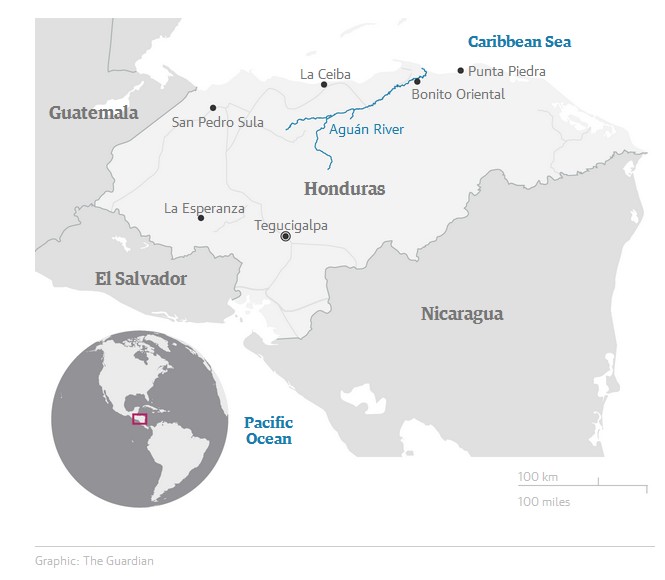Berta
Cáceres's name was on Honduran military hitlist,
says former soldier
A unit trained by US special forces was ordered to
kill the environmental activist who was slain in
March, according to an ex-member who now fears for
his life
By Nina Lakhani in Mexico City
Berta Cáceres, the murdered environmental
campaigner, appeared on a hitlist distributed to
US-trained special forces units of the Honduran
military months before her death, a former soldier
has claimed.
Lists
featuring the names and photographs of dozens of
social and environmental activists were given to two
elite units, with orders to eliminate each target,
according to First Sergeant Rodrigo Cruz, 20.
Cruz’s unit
commander, a 24-year-old lieutenant, deserted rather
than comply with the order. Cruz – who asked to be
identified by a pseudonym for fear of reprisal –
followed suit, and fled to a neighbouring country.
Several other members of the unit have disappeared
and are feared dead.
“If I went
home, they’d kill me. Ten of my former colleagues
are missing. I’m 100% certain that Berta Cáceres was
killed by the army,” Cruz told the Guardian.
Cáceres, an
indigenous Lenca leader who won the prestigious
Goldman Environmental Prize in 2015 for a campaign
against the Agua Zarca hydroelectric dam,
was shot dead in her home in March. Before her
murder, she had reported 33 death threats linked to
the campaign and had warned international human
rights delegates that her name was on a hitlist.
According
to Cruz, Cáceres’s name appeared on a list given to
a military police unit in the Inter-institutional
Security Force (Fusina),
which last summer received training from 300 US
marines and FBI agents.
Five men
have been arrested for her murder, including Maj
Mariano Díaz Chávez, an active-duty major in the
Honduran army. Díaz had previously participated in
joint US-Honduran military operations in Iraq, and
is reported by local media to be a graduate of the
elite Tesón special operations course which is
partly taught by US special forces.
Diaz was a military police instructor when arrested,
but has since been
given a dishonourable discharge.
Annie Bird,
director of the group Rights and Ecology which
documents human rights abuses in
Honduras, said: “Cruz’s testimony suggests death
squads are targeting political opposition, but the
justice system is so broken, and directly controlled
by figures implicated in corruption, that there is
no one [in Honduras] who can credibly investigate.”
The
Guardian interviewed Cruz several times by telephone
and video call, and spoke with several people –
academics, community leaders and activists – who
have interviewed Cruz and confirmed his identity and
military background.
Cruz
enlisted in the army in December 2014, and after
three months of basic training, was transferred to
the 7th Battalion of the military police, which was
created in 2013 to replace a civilian police force
mired in allegations of corruption and abuse.
He
completed two gruelling specialist training camps,
including the Tesón course, where he received
instruction from foreign military advisers including
Americans, Colombians and instructors who spoke a
foreign language which Cruz could not identify. Last
year, the Tesón course became the subject of intense
controversy when footage emerged showing a trainee
being
forced to eat the head of a dog.
During his
training, Cruz was hospitalized twice with
dehydration, but he completed the course and in
October last year, Cruz and 15 other men from his
battalion were picked to serve in the Xatruch
taskforce – one of two multi-agency forces in
Honduras deployed on specialist counter-narcotics
and anti-gang operations.

The Xatruch
force covers the Caribbean coast,
which has become an important way station for drug
cartels smuggling cocaine from South America to the
US. The second taskforce, Fusina, operates
nationwide.
In
mid-December, Cruz’s commander gathered his
subordinates after a Tuesday evening football match
and showed them several sheets of paper with names,
photographs, addresses and phone numbers of each
target. One list was assigned to their unit; the
second to a similar unit in Fusina.
“The
lieutenant said he wasn’t willing to go through with
the order as the targets were decent people,
fighting for their communities. He said the order
came from the joint chiefs of staff [and] he was
under pressure from the Xatruch commander to
comply,” Cruz said.
A few days
later, the lieutenant left the base and has not been
seen since. |